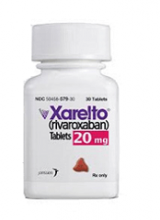Both low-dose and full-dose rivaroxaban had superior benefit-risk profiles for extended venous thromboembolism (VTE) treatment when compared to aspirin, according to investigators.
The team found the combined outcome of recurrent VTE and major bleeding was less likely to occur in patients treated with rivaroxaban at 20 mg or 10 mg than in patients treated with aspirin.
Paolo Prandoni, MD, of the University of Padua in Italy, and his colleagues reported these results in Thrombosis Research.
The investigators analyzed data from the EINSTEIN-CHOICE trial, a double-blind, randomized study of 3,365 patients age 18 or older with deep vein thrombosis (DVT) or pulmonary embolism (PE) who had previously received anticoagulant treatment for 6 to 12 months.
Patients were given once-daily rivaroxaban at a low dose (10 mg), once-daily rivaroxaban at the full dose (20 mg), or once-daily aspirin at a dose of 100 mg.
The incidence of the combined outcome of recurrent VTE and major bleeding was 2.8% lower in the 20 mg rivaroxaban arm and 3.4% lower in the 10 mg rivaroxaban arm than in the aspirin arm.
The cumulative incidence of recurrent VTE was 1.9% in the 20 mg rivaroxaban arm, 1.6% in the 10 mg rivaroxaban arm, and 5.0% in the aspirin arm.
The cumulative incidence of major bleeding was 0.7%, 0.4%, and 0.5%, respectively.
Benefit-risk profile
Benefit and risk were calculated using “excess numbers of events,” or the difference in cumulative incidences in a hypothetical population of 10,000 VTE patients treated for 1 year.
Excess numbers of events were defined as the number of patients in this hypothetical population who would experience a particular event when treated with rivaroxaban (at either dose), minus that in the same population treated with aspirin.
In patients treated with 20 mg of rivaroxaban instead of aspirin, there would be 123 fewer episodes of PE (95% confidence interval [CI], 21-226) and 198 fewer episodes of DVT (95% CI, 62-333).
In patients given 10 mg of rivaroxaban instead of aspirin, there would be 121 fewer episodes of PE (95% CI, 4-238) and 217 fewer episodes of DVT (95% CI, 92-342).
Net clinical benefit was defined as the composite of symptomatic recurrent VTE and major bleeding events. It occurred in 23 patients in the 20 mg rivaroxaban arm, 17 patients in the 10 mg rivaroxaban arm, and 53 patients in the aspirin arm.
For 10,000 patients treated for 1 year with rivaroxaban instead of aspirin, there would be 284 fewer net clinical benefit outcomes for the 20 mg dose (95% CI, 106-462) and 339 fewer (95% CI, 165-512) for the 10 mg dose.
This means that one additional symptomatic recurrent VTE or major bleed would be avoided for every 36 patients treated with rivaroxaban at 20 mg or every 30 patients treated with rivaroxaban at 10 mg.
The investigators therefore concluded that rivaroxaban “provides a clinically important benefit in terms of reduction in recurrent VTE” and has a favorable benefit-risk profile relative to aspirin.
In fact, the team said there is “no longer a place” for extended VTE treatment with aspirin.
Bayer AG funded this study. Dr. Prandoni reported financial relationships with Bayer, Sanofi, Daiichi Sankyo, and Pfizer.


